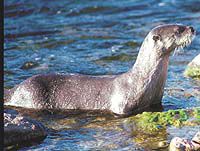| The Division of Wildlife Resources report they are studying the possibility of releasing otter in Straight Canyon. |
The Emery County Public Lands Council began their new year with a discussion on river otters with the Utah Division of Wildlife Resources. Tony Wright is a native wildlife species biologist with the DWR. Rick Larsen, DWR regional director, introduced him to the council. Larsen said the Northern River Otter Management Plan was approved in 2005 by the Wildlife Board. As an ammendment to that plan, three sites are being considered around the area to introduce otters.
The Wildlife Board is hearing the proposal at its Jan. 8 meeting as a matter of information. Further discussion needs to take place among interested parties before any decisions on the reintroduction can be made. Larsen said they are also contacting the Farm Bureau for their input on the matter. The reintroduction is still several months in the future. The animals for transplant usually come from nuisance animals in other areas.
The DWR is trying to introduce the otters along their historic range. They will also look at the feasibility of a short trapping season. Wright reported otters are mainly fish eaters and will also eat small mammals and birds. In this area, Huntington Creek was considered, but eliminated because of the whirling disease of some of the fish in Huntington Creek. It is not known if otters could spread whirling disease.
Scofield and Straight Canyon were also considered. The DWR concluded that Straight Canyon could be a good fit for the otter. The Joe’s Valley Reservoir is filled with chubs, which the otter could feed upon. The DWR didn’t see any conflicts to the introduction of the otter, but is now seeking public input. Otters traditionally feed upon slower fish. They do not have a negative impact on fisheries. Otters travel in small groups and do not burrow so they are no threat to dikes.
One potential area of concern is with trapping regulations. Some areas where otters have been released don’t restrict trapping. Otters can be caught in beaver traps, but those traps can be adapted so they won’t trap otters. Beaver trapping can continue in an area where otters are introduced.
The legal status of otters is a tier 3 which is an every day species and not sensitive.
Public lands director, Ray Petersen wondered if there is any impact on the irrigation systems of areas with otters. Wright said there are numerous otters in the Uintah Basin and no reports of problems with their irrigation systems. The otters stick to the main bodies of water as the smaller canals don’t have enough fish to keep the otters well fed.
Wright said they would like to give the otter a try and if they aren’t suitable to this area, then that’s the otter’s decision.
Priscilla Burton, council member wondered if the otters compete with any animals already here. Wright said they really don’t have a competitor. They focus on different foods than weasels or minks. They possibly could compete with fish eating birds, but that is not likely.
Larsen said the otters are quite popular with the locals when the otters have been spotted on the Green River; the locals have enjoyed seeing them.
Wright said the only place the otters have been a problem is when they got into the White Rocks hatchery, those otters were moved.
Jay Mark Humphrey, director of the Emery Water Conservancy District expressed concern the DWR hadn’t gone to the water users about the selection of Straight Canyon to release otters. He said are we going to sacrifice the fish in Straight Canyon for the otter? The water coming out of Joe’s Valley is extremely cold. Is cold water a good habitat for the otters, he questioned. Straight Canyon doesn’t have a guaranteed flow of water. Sometimes Joe’s Valley Reservoir is drawn down. Humphrey wondered if these things have been considered. There isn’t a beaver dam in Straight Canyon. The irrigation systems in the county are connected and any otter released in Straight Canyon could make its way to the Huntington River also.
Larsen suggested a meeting be planned where the concerned parties can discuss Humphrey’s concerns. The meeting is tentatively set for six weeks.
Craig Johansen, president of Cottonwood Creek irrigation company said initially they wondered if the otter was a protected specie and if they would manage the habitat for the otter. He is glad that isn’t the case. He reminded the DWR that Straight Canyon has no conservation flows and that flow can be shut-off entirely if the need arises.
Currently two towns get their water from there. There’s not much water coming down Straight Canyon, enough for the towns and livestock watering. A lot of the water is iced over at this time.
Larsen said the otter is not a sensitive specie and the otter would adapt to the management of Joe’s Valley and not the other way around.
Johansen said he is opposed to the release of otter until an agreement could be worked out which states the otter will not affect the water management of Joe’s Valley Reservoir and downstream.
Larsen said such an agreement can be worked on.
It was also stated Straight Canyon doesn’t have that much of a fish supply and the otters will eventually end up in Joe’s Valley.

